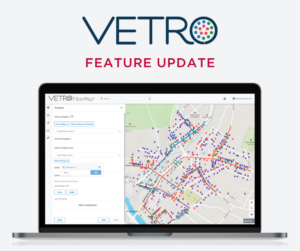Charting Your Course to a Profitable Fiber Deployment
So you’ve done your due diligence, placed your infrastructure, and put a plan in place to address future incongruities. You’ve got your WHERE, you’ve got your WHAT – now it’s time to find your HOW. How am I going to get people connected? How am I going to get the word out about my lightning-fast broadband service? What steps should I take, from a marketing analysis standpoint, to make sure residents in my service area are educated and up to date on the possibilities of broadband?
Work doesn’t end when the network is built; in fact, there’s an argument to be made that building is the simplest part of the job. You need to drive adoption of your new broadband service, and you’ll once again need powerful geospatial analysis tools to help do so. You have teams across your organization, from marketing and sales to installation crews, who need information about where your facilities are in relation to prospective customers to do their jobs effectively.
Planning Sales Routes and Qualifying Prospective Customers
Selling broadband effectively and smoothly requires baseline knowledge of which buildings are serviceable, and which are not. Unfortunately, the logistics of construction often mean that the answer to this question isn’t always cut and dried. Long driveways, underground parking lots, and the complex logistics of multi-tenant buildings all come into play, leaving some properties permanently unserved, like barren islands in a sea of serviceable customers. This makes outbound marketing and sales tools critical to qualifying responses to inbound inquiries.
To support an effective marketing and sales campaign, your systems will need to support:
- Street level routing for door to door sales teams
- Point and radius or .kmz polygon export for digital advertising
- Address list export for direct mail campaigns
- Address qualification and lateral estimation to enable responses to ad-hoc inquiries
Whenever possible, sales and marketing teams should focus first on buildings that are already “lit” with fiber broadband service, or can be serviced by installing a simple drop. For your sales team, this requires street-level map routes that identify serviceable buildings on each street, as well as the buildings that are already served. This can help avoid the embarrassment of making a sales call at the door of an existing customer. During the early days of a campaign, subscribed addresses will change daily, so the data needs to be tight, accurate, and constantly refreshed. A reliable, flexible system of record will help keep the sales team in sync with sign ups, avoiding embarrassing situations or time wasted chasing down existing customers.
Geospatial Marketing Requirements
Once you have an idea of who you’re targeting for service, it’s time to set your marketing campaigns in motion. Targeted digital advertising and direct mail campaigns are tried and true strategies used by marketing teams the world over. Digital advertising can be as granular as street level, and as broad as zip code level, depending on the platform used. Leveraging platforms like the Google Ad network or Facebook’s ISP Toolbox requires an understanding of the most effective means of targeting for each service area, not to mention formatted data that your marketing team can easily upload into the advertising platform.
Direct mail is a little different, as this method relies exclusively on address-level data. Physical addresses will work in most cases, but they’ll need to be scrubbed for incongruities like PO boxes. In addition, your campaign will be more effective where you can append a recipient’s name to the address. Lastly, while direct mail remains an effective strategy, it’s getting more expensive as time geos on. As a result, this method requires that you be able to identify serviceable locations and export the data in a format that can be easily and effectively used by the mailing service provider.
Of course, not every opportunity is going to arise from a conventional targeted campaign. Part of the beauty of sales is finding new customers from new channels. A customer may have seen an advertisement out in the world, been referred by another customer, or met a salesperson at a local spot. In these cases, your salesperson will need to quickly determine this prospective customer’s eligibility. This will require your system to easily allow your sales team to search for and qualify addresses in real time. Your system should also allow your engineering team to quickly estimate and quote extensions to serve buildings that were previously not connected.
Provisioning and Capacity Management
If you’ve built your network in a capital efficient way, your capacity is probably based upon a realistic, or perhaps even aggressive estimate of your eventual take rate that is not 100%. But what happens if take rates exceed expectations in certain areas? As more orders come in, your engineering team will need to keep an eye on the network for capacity and keep ahead of any augments that may be required if demand in a certain area exceeds your expectations. Your fiber management system should allow you to keep tabs on the available fiber strands, splitters, OLT and MSU ports, so that you don’t end up with disappointed potential customers if growth exceeds capacity. To facilitate this effort, your system should show you clearly when a certain network segment is near its capacity threshold.
By that same token, when you take an order, your provisioning team is going to need access to a customer’s exact location, as well as all of the associated records with that address. They’ll need to select the OLT port, strands, splitters, etc. best suited to serve the customer. A well-designed fiber management system will be able to provide this information to your field technicians who will complete the installation in the field. Like many other aspects of managing your fiber network, provisioning and capacity management are easier when you have a flexible, reliable system of record consistent across every part of your organization.
What’s Next?
Join us next time when we’ll jump into the final step if your profitable deployment: keeping customers connected. You’ve got them lit, now you need to keep them lit. How will you manage outages or repairs? How will you keep your customers abreast of new developments in their area? We’ll dig a little deeper into these questions in our next and final post. Keep your eyes peeled!
If you can’t wait, download our Guide to Building a Profitable Fiber Network.


